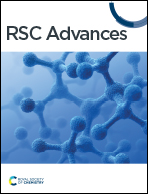Effect of hydrophobized PET TeMs membrane pore-size on saline water treatment by direct contact membrane distillation†
Abstract
This paper describes the desalination process by membrane distillation (MD) using track-etched membranes (TeMs). Hydrophobic track-etched membranes based on poly(ethylene terephthalate) (PET TeMs) with pore diameters from 700 to 1300 nm were prepared by UV-initiated graft polymerization of lauryl methacrylate (LMA) inside the nanochannels. Modified PET TeMs were investigated by Fourier transform infrared (FTIR) spectroscopy, atomic force microscopy (AFM), scanning electron microscopy (SEM), thermogravimetric analysis (TGA) and contact wetting angle (CA) measurements. Hydrophobic PET TeMs were tested for treating saline solutions of different concentrations by the direct contact membrane distillation (DCMD) method. The influence of membrane pore diameter and salt solution concentration on the water flux and rejection degree were investigated. Membranes with CA 94 ± 4° were tested in the direct contact membrane distillation (DCMD) of 7.5–30 g L−1 saline solution. Hydrophobic membranes with large pore sizes showed water fluxes in the range of 1.88 to 11.70 kg m−2 h−1 with salt rejection values of up to 91.4%.



 Please wait while we load your content...
Please wait while we load your content...